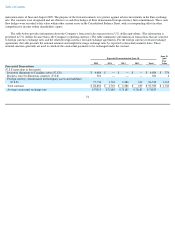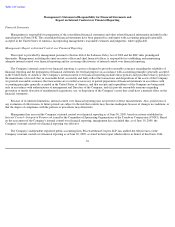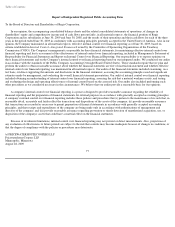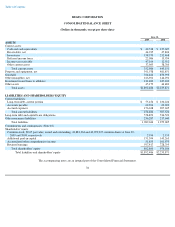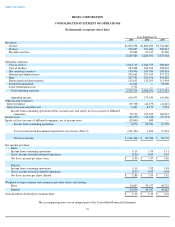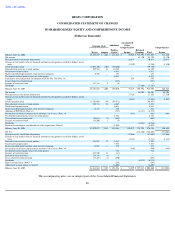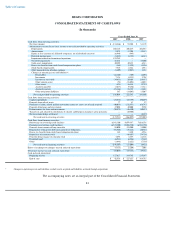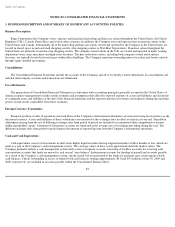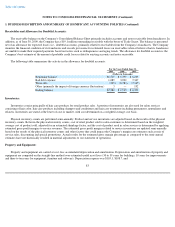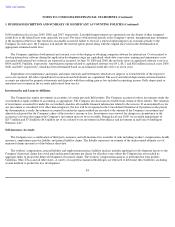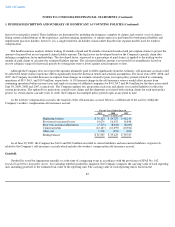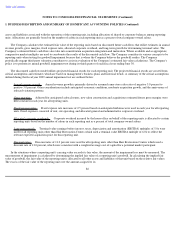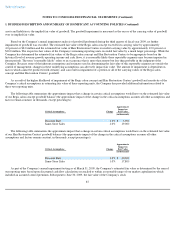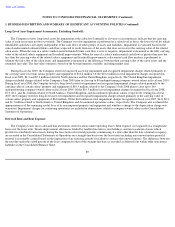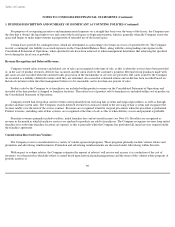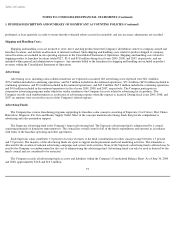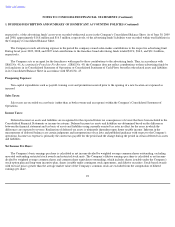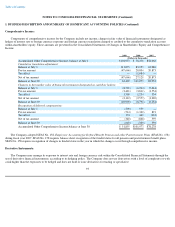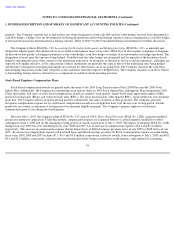Supercuts 2009 Annual Report Download - page 86
Download and view the complete annual report
Please find page 86 of the 2009 Supercuts annual report below. You can navigate through the pages in the report by either clicking on the pages listed below, or by using the keyword search tool below to find specific information within the annual report.
Table of Contents
NOTES TO CONSOLIDATED FINANCIAL STATEMENTS (Continued)
1. BUSINESS DESCRIPTION AND SUMMARY OF SIGNIFICANT ACCOUNTING POLICIES (Continued)
$104.9 million in fiscal years 2009, 2008, and 2007, respectively. Leasehold improvements are amortized over the shorter of their estimated
useful lives or the related lease term, generally ten years. For leases with renewal periods at the Company's option, management may determine
at the inception of the lease that renewal is reasonably assured if failure to exercise a renewal option imposes an economic penalty to the
Company. In such cases, the Company will include the renewal option period along with the original lease term in the determination of
appropriate estimated useful lives.
The Company capitalizes both internal and external costs of developing or obtaining computer software for internal use. Costs incurred to
develop internal-use software during the application development stage are capitalized, while data conversion, training and maintenance costs
associated with internal-use software are expensed as incurred. At June 30, 2009 and 2008, the net book value of capitalized software costs was
$40.4 and $41.0 million, respectively. Amortization expense related to capitalized software was $9.1, $8.3, and $8.8 million in fiscal years 2009,
2008, and 2007, respectively, which has been determined based on an estimated useful life of five or seven years.
Expenditures for maintenance and repairs and minor renewals and betterments which do not improve or extend the life of the respective
assets are expensed. All other expenditures for renewals and betterments are capitalized. The assets and related depreciation and amortization
accounts are adjusted for property retirements and disposals with the resulting gain or loss included in operating income. Fully depreciated or
amortized assets remain in the accounts until retired from service.
Investment In and Loans to Affiliates:
The Company has equity investments in securities of certain privately held entities. The Company accounts for these investments under the
cost method or equity method of accounting, as appropriate. The Company also has loans receivable from certain of these entities. The valuation
of investments accounted for under the cost method considers all available financial information related to the investee. If an unrealized loss for
any investment is considered to be other-than-temporary, the loss will be recognized in the Consolidated Statement of Operations in the period
the determination is made. Investments accounted for under the equity method are recorded at the amount of the Company's investment and
adjusted each period for the Company's share of the investee's income or loss. Investments are reviewed for changes in circumstance or the
occurrence of events that suggest the Company's investment may not be recoverable. During fiscal year 2009, we recorded impairments of
$25.7 million and $7.8 million ($4.8 million net of tax) related to our investment in Provalliance and investment in and loans to Intelligent
Nutrients, LLC.
Self-insurance Accruals:
The Company uses a combination of third party insurance and self-insurance for a number of risks including workers' compensation, health
insurance, employment practice liability and general liability claims. The liability represents an estimate of the undiscounted ultimate cost of
uninsured claims incurred as of the balance sheet date.
The workers' compensation, general liability and employment practices liability analysis includes applying loss development factors to the
Company's historical claims data (total paid and incurred amounts per claim) for all policy years where the Company has not reached its
aggregate limits to project the future development of incurred claims. The workers' compensation analysis is performed for four models;
California, Ohio, Texas and all other states. A variety of accepted actuarial methodologies are followed to determine these liabilities, including
several methods to predict the loss development
84


